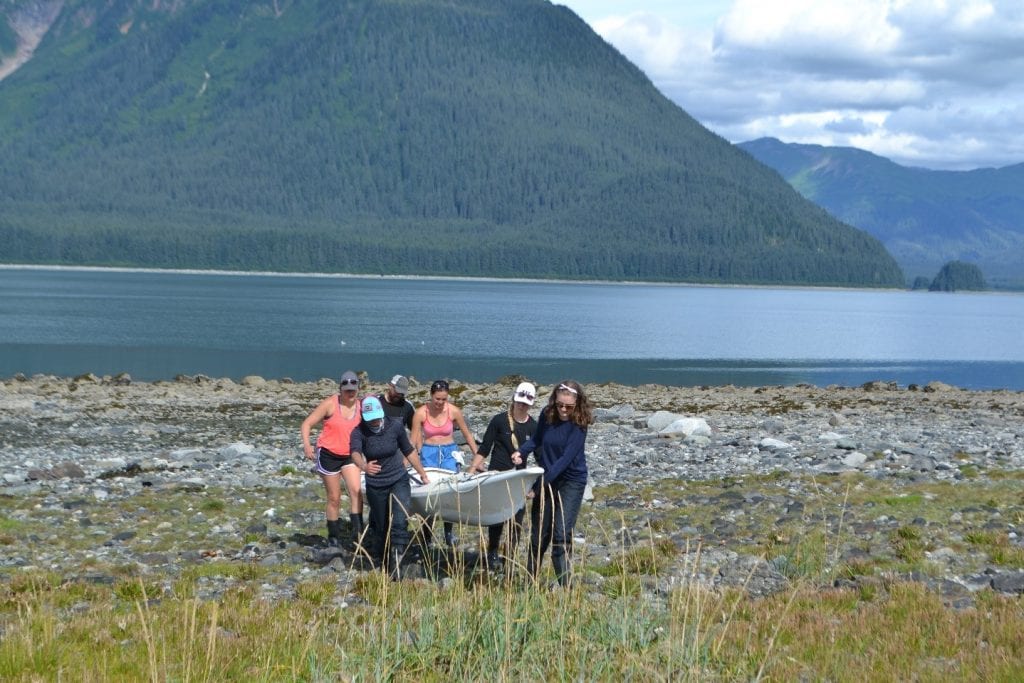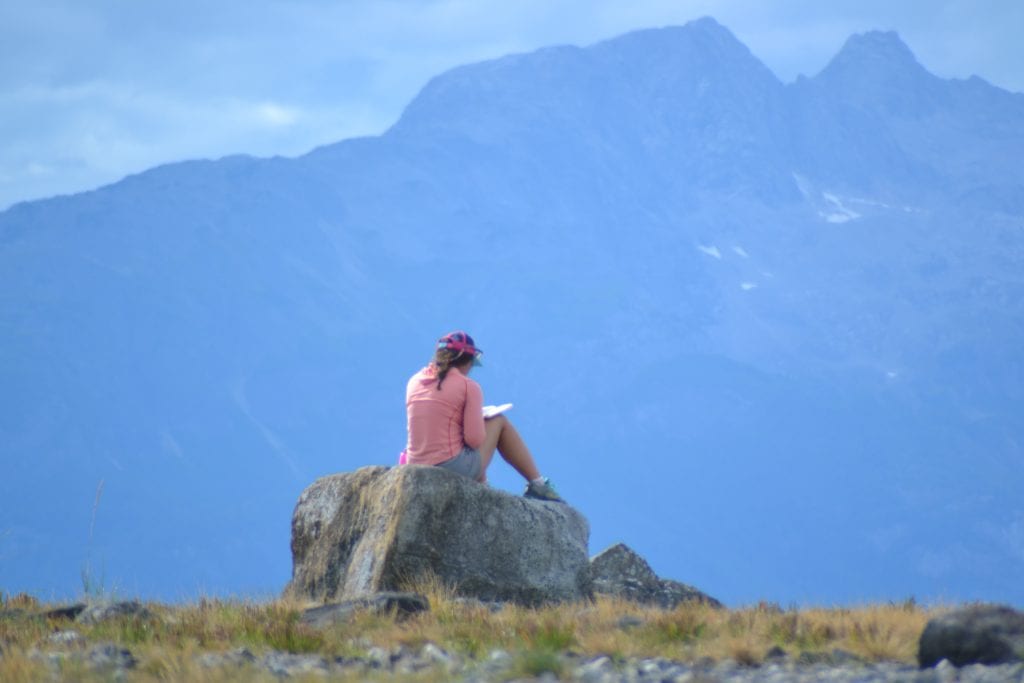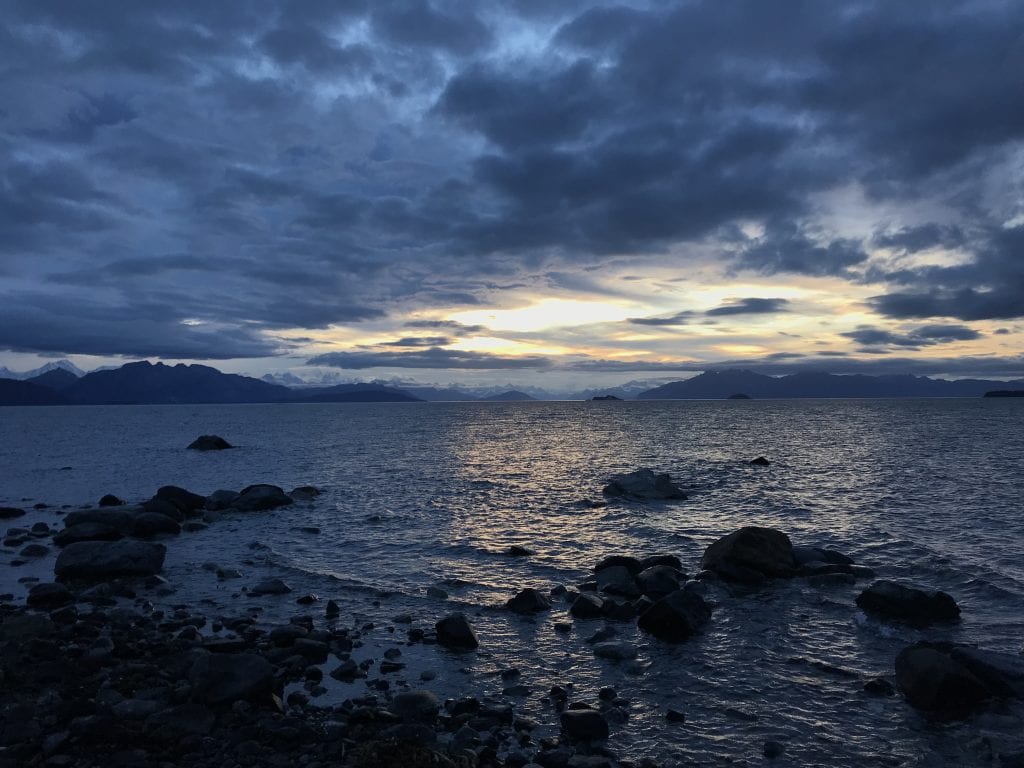By Maddie Joy
“You paddle a canoe; you wear a kayak.” –Kim Heacox, The Only Kayak
Kelp: Ribbons if iodine/unrolled by fingers/of waves. –Nora Marks Dauenhauer, The Droning Shaman
August 4th, 2018
Everyone in camp woke up at 7 am…but not me. I woke up late, at 8:45 am, and had to run to the Tribal House for our discussions that were supposed to start at 9 am. When I arrived, everyone was already in attendance, and Paula kindly offered me some tea and snacks. I quickly made my tea, and then went to sit down with everybody.
Around 9:30, we started Calvin’s discussion. It was a very interesting/thought-provoking conversation that discussed the continuing of culture through generations, and the different roles and required signs of respect for each step forward. Calvin, a member of the Grand Ronde tribe has wrestled personally with what it means to be Native in the 21st century, respecting tradition, while being open to other cultural influences. It was especially valuable to be able to have these discussions with Sally Jewell, who was again joining us, before she departed from us, for the rest of our journey.

Our group inside the tribal house, with Paula, tribal interpreter on left, and Sally Jewell, far right. (Tim Billo)
We then took a small break, and moved right into Marco’s discussion about ANILCA and its effects on subsistence in rural Alaska. He started out by telling us a story, a story he heard from a man on the ferry, who was bragging about having participated in the killing of a beluga whale, just two years after moving into rural Alaska. The way he talked about this killing, as if it was just for trophy, and “thrill of the kill,” made us all sick to our stomachs as Marco retold the story. The person telling the story may be an outlier, but it truly made us think about subsistence, and whether or not it should be extended to all rural Alaskans (as it currently is), or just be a component in the lives of the Native people. Sally then talked a little about “bears over bait,” which is a practice in which people lure bears and then shoot them. She had previously abolished it as Secretary of the Interior, however it has soon been reversed in the current administration. After I heard about these two horrific trophy-hunting related-instances, it made me very angry and sad, as I think how most of the class also felt at this point. These stories definitely skewed many views, and just generally put a sour taste in everyones’ mouths, so we decided to stop the discussion and continue it another day.

Presenting a thank you card to Paula for kindly taking care of us at Xunaa Shuka Hit, and courageously offering very personal and emotional insight into her culture.
We had lunch on the beach, around midday, all hoping that it was the last day of tortillas, cheese, and Sriracha. We then packed up our camp, put only the “essentials” into dry bags, and then went on our way to meet with the guides and get geared up to start the trip!
We departed around 4:30. So exciting! Kim Heacox and Sally Jewell paddled out with us to say goodbye. It was very bittersweet. A part of me felt like I was leaving my new home, and it was very sad to leave all the amazing people we had met and spent time with, however I was very excited for the next part of this amazing journey-8 days in the Southeast Alaskan Wilderness, kayaking up the East Arm of Glacier Bay.
After about 2 miles into kayaking through the Beardslee Islands, Calvin and Owen’s kayak rudder broke, so the guides decided that we would only go 2 more miles. Kayaking with a broken rudder is no easy feat, as could be seen from Calvin and Owen’s kayak going around in circles, with both of them trying their hardest to stay going straight. We ended up seeing a sea otter, a few loons, throngs of white-winged scoters and Bonapartes gulls, and a few porpoises, and we all got so excited for each wildlife spotting. It was fun!
We kayaked for a total of 4 miles in 2 hours and ended up on this super cute island with 3 tent spots in the woods, and 2 tent spots on the surrounding shore. The “bathroom” beach was established on the opposite of that of the “kitchen,” doubling as the place where we carried/ placed/ and unloaded the boats.
Within an hour of being on the island, we all were having some private journaling time, when we heard Sean yell “BEAR.” We all ran over and yelled “HEY BEAR” to an adorable, smaller, female black bear who was just wandering around near our camp. She eventually swam across to the nearby island, which was very cool to watch.

Sea otter skull, and skeleton below. Sea otter populations may be beyond their carrying capacity. Weakened, they sometimes haul out on land, where they become prey for wolves. This skull was part of an intact skeleton, which looked like it hadn’t been scavenged in any way.
For dinner we had stir-fried veggies and rice. VEGGIES. I think we all were at the point of being so done with straight carbs and would be willing to do anything to have fresh fruit and vegetables. IT WAS AMAZING.
I remember thinking about how happy I was after this day. I wrote in my journal that “my heart is so warm…I’m in the most beautiful, peaceful place in the world with absolutely amazing people.” It was an amazing start to the kayaking trip, and it made me so excited for the days to come.
August 5th, 2018
Kelp: Ribbons of iodine/ unrolled by fingers/ of waves. –Nora Marks Dauenhauer, from The Droning Shaman
Today marked the halfway point of the full trip. It also was my favorite day of the entire journey. Also, Happy Birthday Mackenzie!
We woke up early, had some breakfast, fixed Owen and Calvin’s kayak, and then were on our way. Today, we were going to be heading to an island known as “Christmas Tree Island,” by the AMG guides, or “Bear Track Cove,” by everyone else living around Glacier Bay. It was roughly seven miles away from the small island we were departing from.
After kayaking for about an hour and a half, we stopped on a little island for lunch. While munching on tortillas and beach asparagus (the local name for “pickle weed” or Salicornia), all of the sudden, we see Tim running towards us from the beach hiding away in the distance. “Hey guys, there’s a humpback feeding over here, hurry!” he said. We all quickly ran over and were immediately amazed by what we saw. There were two humpback whales, a larger and a smaller one, just swimming around a small cove, very close to shore, and feeding. It was such a beautiful and peaceful moment for everyone. We all stood silent, in awe, watching the sprays come closer, the tails go farther, and listening to the sounds of the whales breathe, that sent goosebumps and shivers down my skin.
When we got back on the water again, we all stopped to admire a cute sea otter, playing around in the kelp. Jayna then spotted something move on shore, so we all pulled out binoculars to take a closer look. Sure enough, there was a mama and two baby moose walking along the beach. We watched as they majestically moved across the rocks, and then across the small river, and into the forest. On top of it all, the two humpbacks, from earlier, were nearby, breathing and spurting, a sound and a sight to be remembered for the rest of the trip. This moment was all-around amazing, and truly encapsulated the richness of wildlife and diversity found in Glacier Bay National Park.
When we were within a mile of our destination, we hit dead end to land, as we had hit the shallowest part of the canal at exactly low tide. We then had to all get onto land, and lug the 300-pound, gear-filled boats to the other side of the water-filled channel. Six people to a boat, climbing a hill over 20 yards, was no easy feat, but together as a team, we accomplished our goal.

Working as a team to carry the boats up shore, enjoying the last hours of summer sun (the weather would take a drastic change the next day). (Tim Billo)
Despite the roadblock, we eventually made it to “Christmas Tree Island” and enjoyed all of the small spruce trees lining the beach, interspersed with a carpet of wild strawberry and soapberry shrubs. After setting up camp, we all went off to have some private journaling time, and a moment to just take in the immense beauty surrounding us. During this time, I wrote- “I am sitting on the roots of a fallen log on the beach, on the last of the Beardslee Islands, looking into the entrance of Glacier Bay and the beautiful snowcapped mountains. I am listening to two humpback whales breathe and I am watching them spray out their water, creating towers of mist in the distance. I’m watching Jayna watch a harbor seal, that is watching her. The ultimate stare down. It’s just so quiet, still, and inspiring. I am able to hear myself think.”
It truly was some much-needed alone time for everyone, a time to just process everything we had been experiencing over the last week and the wildness surrounding us.
We then did Natalie’s discussion about sustainability, and talked about all of our different definitions, and how there truly can’t be one concrete meaning, as it can encompass so many things. We talked about cultural sustainability and the relationship to the Tlingit, environmental sustainability in the park, and many others such as economic, political, and social sustainability. We also compared different organizations such as HIA (Hoonah Indian Association), HNFP (Hoonah Native Forest Partnership), Hoonah Totem, the National Park Service, and the National Forest Service to discuss which aspects of sustainability appeal most to each of their missions.
After dinner, Abby and I then tag-teamed our discussions about the concept of “wilderness.” We asked the group whether different situations could be considered true “wilderness,” such as Glacier Bay, with two cruise ships entering its waters each day. There were many mixed views on many of the topics, and it was interesting to hear everyone’s inputs.
Towards the end of our discussion, the clouds covering the Fairweather mountain range began to lift, and it was as if all of the sudden, we were looking into the depths of heaven. We then spent the next hour just watching the sun set over the Fairweather mountain range, looking into the West and East Arms of Glacier Bay as the backdrop for all the wildlife in the waters in front of us. This was the perfect ending to a perfect day and I will remember all the beauty forever.
Reflection:
I have traveled many places around the world, been among many wonders, and been blessed to spend time with some amazing people, but this trip was the most amazing experience I have ever been a part of. I got the opportunity to firsthand communicate with and learn from amazing people such as Bob Starbard, Mary Beth Moss, Philip Hooge, Sally Jewell, and those from the wonderful communities of both Hoonah and Gustavus. I got to experience the most generous hospitality I ever have in my entire life, and the most “wild” wilderness that I ever thought could be possible. On top of it all though, I was blessed to have made lifelong friends, that will share this amazing experience with me forever.
My most memorable moment and most special memory of the trip occurred right after we all watched the humpbacks feeding near the shore, on the second day of the kayaking trip. After about 15 minutes, everyone started to walk back to finish lunch, however I wanted to stay just a bit longer, as I was in awe with everything I had been watching. I walked down to the water’s edge, and stood about ankle deep, just looking out at the amazing wilderness surrounding me. It had been a couple minutes since the whales had surfaced, so we thought that they maybe had left the cove and continued their way down the bay. As I was about to turn back to rejoin the group, the large humpback surfaced less than 10 feet away from me, and sprayed, almost close enough to get me wet. I just stood there in awe. It was one of the most amazing moments in my life. It was just me, this whale, and the beautiful wilderness that surrounded me. A moment I will cherish forever. It made me feel so small, and lucky, to be in the presence of such a massive and extraordinary creature, in the most beautiful place in the world.
I experienced a lot of changes in perspective on this journey, and one of the most telling moments was during my discussion about Wilderness. After talking, we all realized that we take for granted our youth, physicality, and ability to go out, not see any people for 8 days, and kayak into truly deep Southeast Alaskan Wilderness. Many of us, including myself, hold judgments towards those who don’t go out and experience wilderness “in the right way” whether that’s going into the backcountry, backpacking, or making your own paths in the “untrekked”. However, we acknowledged that many people do not have the means, especially physically, to experience wilderness in this way, so it could be that maybe taking a guided bear-watching tour, or a cruise ship up the bay, is the only way for them to experience the preserved wonders of the world. We then talked about whether we would rather essentially “share” the wilderness in this way, with the less-conventional wilderness experience and possibly sacrificing the “wildness” of it, or if it was more important for everyone to be able to have some level of wilderness in their life. Before starting this trip, I think that myself and many others on the trip were against the whole idea of exposing more people to National Parks and making them less “wild,” however this trip truly made us appreciate diversity in parks and the importance of exposure, education, and knowledge surrounding the parks, to help sustain them for generations to come.
I also came into this trip with preconceived opinions about hunting, especially the action within national parks. Being the typical nature-lover, liberal college student, I think that my viewpoint can be inferred. I had always praised the idea of the “no-hunting” policies in national parks and wanted all animals protected at all costs, no matter the situation.
Even within my first three days spent in Hoonah, Alaska, my viewpoint completely changed. I listened to the stories, and concepts of lifestyle from the Tlingit people, and realized just how important subsistence and hunting was to their lives. On top of the outrageously expensive prices to buy any food item in Alaska, subsistence and hunting has always been a crucial part of culture/survival to the Tlingit people and all native peoples of Alaska. Not only that, these practices were significant to their original homeland-Glacier Bay. Upon returning to their homeland after the glacier retreated, they were once again forced away by the National Park Service. Their original source all of all resources, food, and home, was now taken away from them, as it had been countless times in the past.
As I kayaked down the east arm of Glacier Bay, and saw upwards of 50 sea otters and seals a day, I realized if there was hunting in Glacier Bay, everything would be okay. There would still be plenty of sea otters, seals, fish, shellfish, gulls, and not create a detrimental impact to the ecosystem. This realization stacked upon the cultural importance of the Tlingit hunting in their homeland, made my view very clear. After meeting many Tlingit members, and hearing the significance and specialness of certain hunting/subsistence practices, I became fully supportive of their ability to access resources within the National Park. I still do not know where my views lie when it comes to extending subsistence to all “rural Alaskans,” especially within a national park, but I do know that I carry a new viewpoint that I did not have coming into the trip.
Realizations like these were reasons why this trip was irreplaceable and truly changed me as a person.
I am just so lucky to have been a part of such a once-in-a-lifetime experience. I remember at the end of the trip, I asked Professor Billo if he was planning on doing this course next year, and he said he was going to try, but we both knew that it would not be the same caliber to the amazement and generosity we got to experience on this journey. Yes, it is likely that it will not rain six inches a day on the group for next summer, however I just do not see it being possible to receive all the opportunities and memories we were given. However, even if there is less perfect “meetings” with all the right people, and not as many perfectly planned activities, it will always be an amazing trip regardless, because Alaska is truly a wonder. This was my third time coming to Alaska, and it will not be my last. I want to continue exploring its beauty and appreciating its wonder for the rest of my life.
Thank you so much Tim, for making this all possible, and for being the best teacher/mentor I have ever had.










